Hyundai Tucson: GPF Regeneration- Description
Description
Continuous Variable Valve Timing (CVVT) system advances or retards the valve timing of the intake and exhaust valve in accordance with the ECM control signal which is calculated by the engine speed and load.
By controlling CVVT, the valve over-lap or under-lap occurs, which makes better fuel economy and reduces exhaust gases (NOx, HC) and improves engine performance through reduction of pumping loss, internal EGR effect, improvement of combustion stability, improvement of volumetric efficiency, and increase of expansion work.
This system consist of
- the CVVT Oil Control Valve (OCV) which supplies the engine oil to the cam phaser or runs out the engine oil from the cam phaser in accordance with the ECM PWM (Pulse With Modulation) control signal,
- the CVVT Oil Temperature Sensor (OTS) which measures the engine oil temperature,
- and the Cam Phaser which varies the cam phase by using the hydraulic force of the engine oil.
The engine oil getting out of the CVVT oil control valve varies the cam phase in the direction (Intake Advance/Exhaust Retard) or opposite direction (Intake Retard/ Exhaust Advance) of the engine rotation by rotating the rotor connected with the camshaft inside the cam phaser.
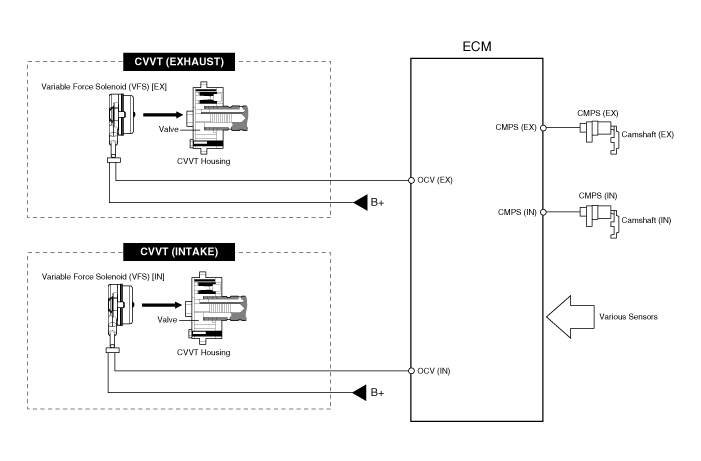
Intermediate Lock CVVT
It increases the retarded amount compared to the default state to expand the operating range of the variable valve timing system.
The cam phase is fixed mechanically so that it is locked at the middle position.

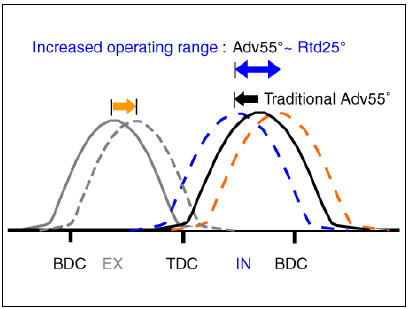
Effect
Improves fuel efficiency by approx. 1.7%.
Expands the intake CVVT operating range.
(Increases the retarded amount by up to 30º compared to the default state.)
ↆ
LIVC (Late Intake Valve Close)
ↆ
- Improves fuel efficiency by reducing pumping loss.
- Improves knocking characteristics by reducing compression ratio.
Operation Principle
The CVVT has the mechanism rotating the rotor vane with hydraulic force generated by the engine oil supplied to the advance or retard chamber in accordance with the CVVT oil control valve control.
WARNING
- The variable force solenoid (VFS) changes its force depending on the PWM duty to control the stroke of the OCV.
- It also controls the lock, unlock, advanced, retarded, and holding functions.
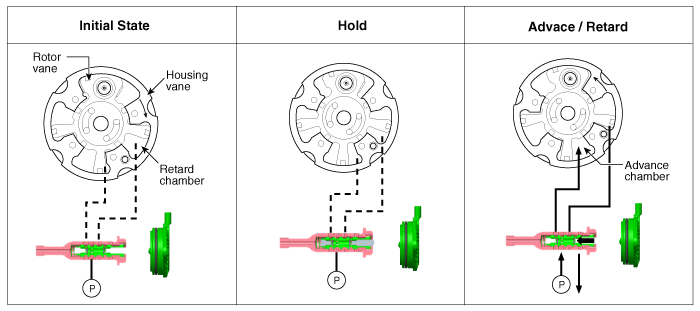
CVVT System Mode

(1) Low Speed / Low Load
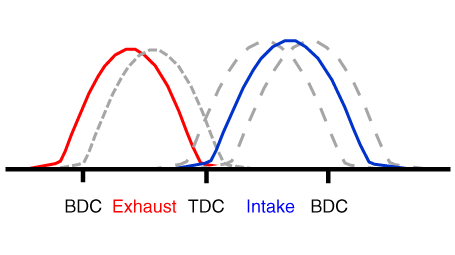
(2) Part Load
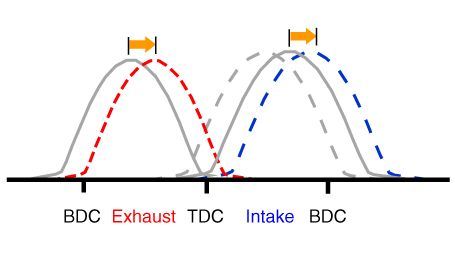
(3) Low Speed / High Load
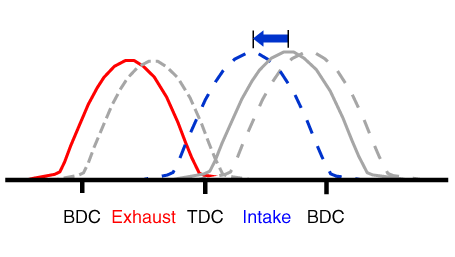
(4) High Speed / High Load
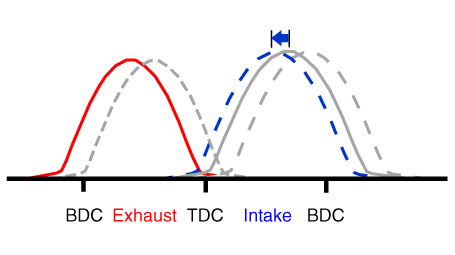

Description
CVVD (Continuous Variable Valve Duration) System is a device to control the optimum open and close timing according to the driving mode by changing the valve opening section.
It is composed of cam shaft, CVVD assembly, and CVVD acatuator.
The valve opening time operates in proportion to the rpm of control shaft.
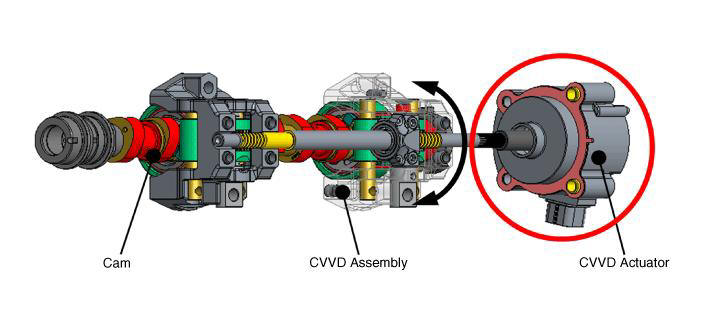
Operation Principle
CVVD System Operating Mode
Optimum Valve Timing by Engine Load
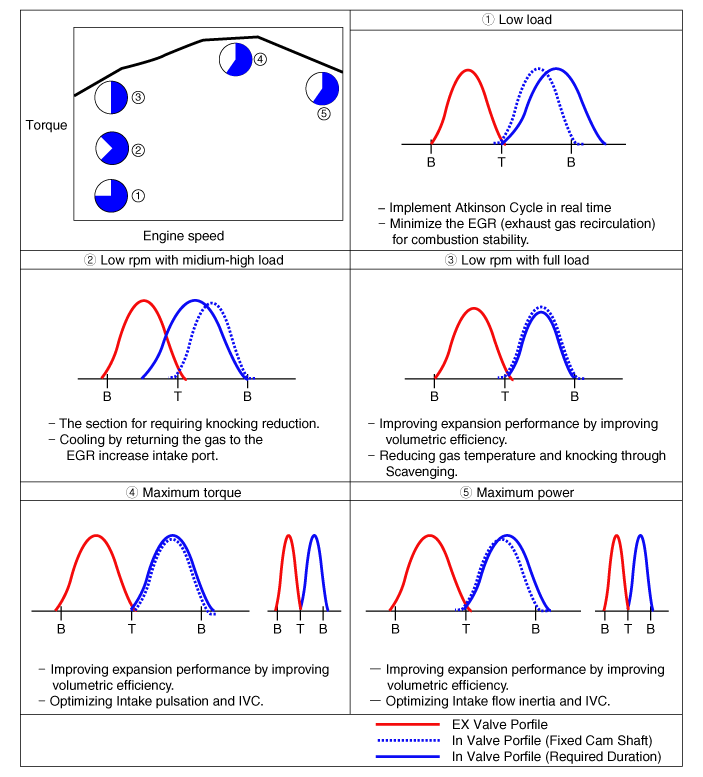
READ NEXT:
 Schematic Diagrams
Schematic Diagrams
Manifold Absolute
Pressure Sensor (MAPS)
Intake Air Temperature Sensor (IATS)
ETC (Electronic Throttle Conlrol)
System
Engine Coolant
Temperature Sensor (ECTS)
Crankshaft Position Sensor
(CKPS)
Camshaft Position Sensor (C
 General Information
General Information
Specifications
Service Standard
Tightening Torques
Lubricants
Special Service Tools
Troubleshooting
SEE MORE:
 Piston Pin - Reassembly
Piston Pin - Reassembly
WARNING
Thoroughly clean all parts to assembled.
Before installing the parts, apply fresh engine oil to all
sliding and rotating surfaces.
Always use new gaskets, O-ring and oil seals.
Install the crankshaft position sensor wheel
 Manual Speed Limit Assist (MSLA)
Manual Speed Limit Assist (MSLA)
Manual Speed Limit Assist enabled
indicator
Set speed
You can set the speed limit when you do
not want to drive over a specific speed.
If you drive over the preset speed limit,
Manual Speed Limit Assist will operate
(set spe
Information
- Home
- Hyundai Tucson - Fourth generation (NX4) - (2020-2023) - Owner's Manual
- Hyundai Tucson - Fourth generation (NX4) - (2020-2023) - Workshop Manual